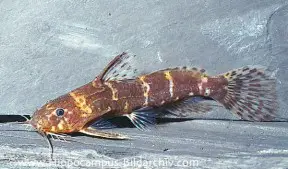Microsynodontis batesii
Dwarf Synodontis
Classification
Mochokidae
Distribution
Recorded from Democratic Republic of Congo, Gabon and Cameroon, where it’s found in the Congo and Ogowe river basins. It’s thought that at least some of these occurences may be different species but as yet this is unconfirmed.
Habitat
Recorded from Democratic Republic of Congo, Gabon and Cameroon, where it’s found in the Congo and Ogowe river basins. It’s thought that at least some of these occurences may be different species but as yet this is unconfirmed.
Maximum Standard Length
3.5″ (8.75cm)
Aquarium SizeTop ↑
24″ x 12″ x 12″ (60x30x30cm) – 55 litres.
Maintenance
A dimly lit aquarium with a soft substrate and rocks, pieces of driftwood and twisted roots arranged to form hiding places suits this species. Lighting should be dim. Plants are appreciated but not essential.
Water Conditions
Temperature: 71-79°F (22-26°C)
pH: 6.7-7.5.
Hardness: 10-15 dH
Diet
Frozen, live and dried foods are all accepted.
Behaviour and CompatibilityTop ↑
M. batesii can be combined with most peaceful species successfully. The most appropriate tankmates include African tetras, dwarf cichlids such as Pelvivachromis or Anomalochromis and small mormyrids. It should not be kept with aggressive or very vigorous fish as it is quite shy. It will not fight with conspecifics and can be kept in groups with no problems.
Sexual Dimorphism
Adult male fish have an elongated caudal fin and small bristles covering the body. The sexes also exhibit differences in the genital papillae in a similar fashion to Synodontis but it is difficult to sex them in this way due to their small size. The papilla of the male is thinner and more pointed than that of the female.
Reproduction
Unrecorded in aquaria.
NotesTop ↑
There are a dozen described species of Microsynodontis but most are not seen in the hobby. This species is one of the commoner ones however. Microsynodontis are much smaller than Synodontis species, with M. batesii being the largest. They can be distinguished from Synos and the similar Mochokiella by the rounded or slightly forked caudal fin. The caudal fin is highly forked in the other genera. Interestingly in Microsynodontis the eyeball is fixed and cannot be moved unlike in Synodontis which has a moveable eye.
When offered for sale this species may exhibit a spotted or reticulated patterning. This is its juvenile colouration and will break up to form the characteristic barring as the fish grows. Care should be taken when acclimatising Microsynodontis as they are often quite delicate when first imported. This species is sometimes seen for sale labelled incorrectly as Synodontis sp. “Nyong”.
Also knoiwn as the african bumblebee catfish


